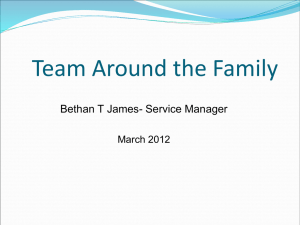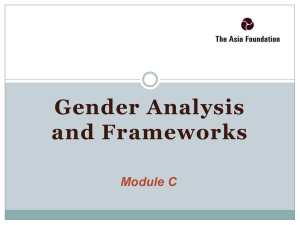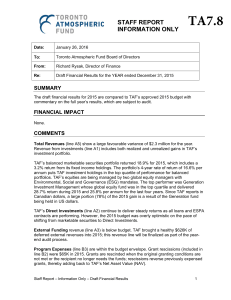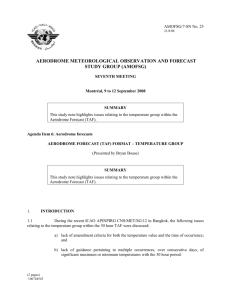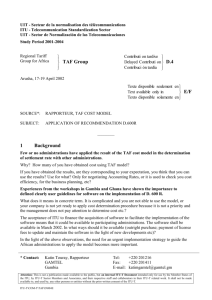TELECOMMUNICATIONS AUTHORITY OF FIJI MONITORING AND EVALUATING THE REFORMED TELECOMMUNICATIONS
advertisement
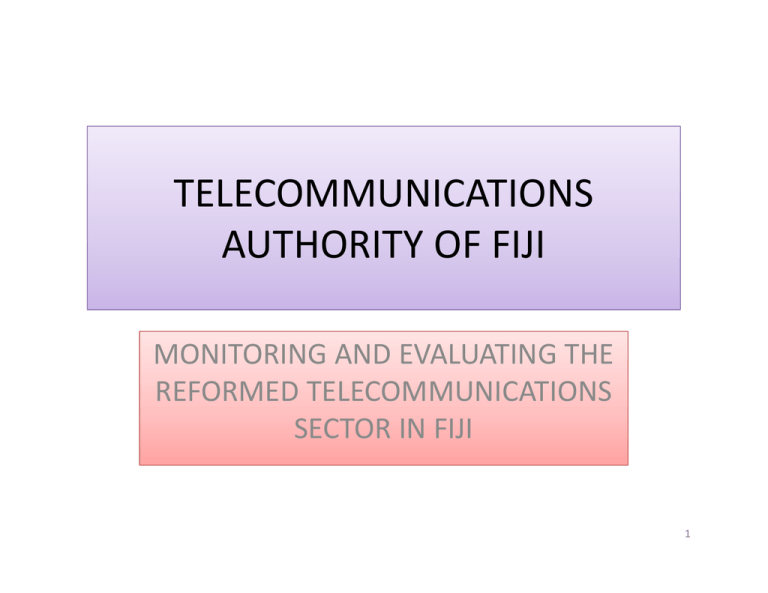
TELECOMMUNICATIONS AUTHORITY OF FIJI MONITORING AND EVALUATING THE REFORMED TELECOMMUNICATIONS SECTOR IN FIJI 1 OVERVIEW • INTRODUCTION • CONSULTANT’S WORK • DESIGNING & IMPLEMENTING THE SYSTEM • THE SYSTEM 2 INTRODUCTION 3 FIJI’S TELECOMMUNICATIONS MARKET •Over 300 islands, 100+ of which is inhabited spread over a vast area – challenge! •POP. 837,000+; 40% URBAN AREAS, 45% PERI URBAN, 15% IN RURAL •600,000+ TOURISTS VISIT OUR SHORES –1 FIXED LINE OPERATOR (VOICE & INTERNET) –2 MOBILE OPERATORS (VOICE & INTERNET) –1 INTERNATIONAL CARRIER WHICH ALSO PROVIDES INTERNET SERVICES VIA WIRELESS INTERNET –1 ISP ONLY –APART FROM THESE MAJOR PLAYERS: •1 X Major Mobile Reseller (Unlicensed) •1 X VoIP CARRIER (Licensed) •3 X CALL CENTRE (Licensed) •RAGULATORY: FCC – COMPETITION; TAF – SERVICE; CCoF – CONSUMER ISSUES •TAF HAS EMBARKED ON ‘OPEN LICENSE REGIME’ •CAPACITY: 3 ENGINEERS, 1 IT SPECIALIST, 4 SUPPORT STAFF •STATS: FIJI BUREAU OF STATISTICS – NSO, TAF – INDUSTRY DATA 4 Background • In 2008 Telecommunication Authority of Fiji (TAF) was established to acquire and develop skills, tools and resources. • Manage the transition from a monopolistic to a competitive and multi operator market; • Facilitate and manage the growth of this industry; and • Measure and optimise the impact of telecommunication reform on the broader community. 5 LONG TERM GOALS OF TAF • Improving access to infrastructure particularly in rural and other island areas; and • Establishing the necessary environment for separate and diverse private sector development. 6 Monitoring and Evaluation System A successful M & E system must have evaluation and reporting back mechanism for wider discussion, decision making and dissipation of the lessons learnt. It will: • Inform TAF if it’s objectives are being met; • Enable examination of impact; • Enable redesign of the activities, if required; and • Enable drawing lessons learnt for future. 7 CONSULTANT’S WORK 8 The M & E Project of TAF An IT based monitoring and evaluation system to be developed to facilitate data submission. It must support: • Information gathering; • Storage; and • Interpretation: – TAF required advice and assistance on evaluation and interpretation of the data gathered, including approaches, methodologies and tools. 9 Goals of the M&E Project Goals of this system were: • Monitor and assess the performance of the telecommunication industry operators in their delivery of services to households and business; • Monitor and assess the performance of the telecommunication industry operators in their delivery for rural and remote areas; • Develop the capacity of TAF to sustain progress; and • Assess and monitor the contribution of the industry to the national GDP. This activity will establish new accountability mechanism for public institutions in Fiji’s telecommunications sector. 10 INFORMATION REQUIREMENTS OF TAF Key Performance Indicators suggested for the M&E System are: • Access: – – – – • • • • Service density by Market Segment, Service density Urban vs. Rural, Network Coverage, Service quality (speed); Usage of scarce resources: spectrum, numbering; Bottlenecks; (legislations, capacity, institutional) Access to and usage of internet; and Broad Data on Industry Revenues. 11 DESIGNING & IMPLEMENTING THE SYSTEM 12 POWER TO COLLECT INFOMATION Power to require information • 31. ‐ (1) The Authority may, by written notice, require a person or licensee to provide the Authority with any information and documents (including information relating to financial matters) as the Authority reasonably requires to perform its functions or exercise its powers as provided for in this Promulgation. • (2) In exercising its powers under this section, the Authority must ‐ – – – – • (3) A person or licensee who refuses or, without reasonable excuse, fails to comply with subsection (1) commits an offence and is liable on conviction – – • (b) for an individual, to a fine not exceeding $1,000 or to imprisonment not exceeding 12 months; (c) for other legal entity, to a fine not exceeding 5 percent of the gross annual revenue of that legal entity. (4) A person or licensee who ‐ – – – • (a) specify the reasons it requires the information and document specified in subsection (1); (b) specify the relevant section of this Promulgation on which the Authority relies to make such request; (c) specify the time, the manner and the form in which any such information is to be provided; and (d) ensure that requirements are reasonable and practicable. (a) intentionally, alters, suppresses or destroys any information or document which the person has been required by a notice under subsection (1) to produce; or (b) provide any estimate, return or other information or document required under any such notice, makes any statement which the person knows to be false in a material particular, or recklessly makes any statement which is false in a material particular, commits an offence and is liable on conviction to a fine not exceeding $2000 or to imprisonment for a term not exceeding 2 years. (5) Without prejudice to subsection (3), if a person or licensee defaults in complying with a notice under subsection (1), a Judge may, on application by the Authority, make an order requiring the default to be made good, including order for costs or expenses of and incidental to the application. 13 DISCLOSURE OF INFOMATION • • • • Limits on disclosure of information 30. ‐ (1) Subject to subsection (3), no confidential information maybe disclosed by the Authority without the written consent of the party who provided such information to the Authority. (2) For the purpose of this section, information is confidential information if the provider of the information has requested in writing to the Authority that information be kept confidential and where the Authority is satisfied that the request is reasonable. (3) The Authority shall determine the reasonableness of a request under subsection (2) taking into consideration: – (a) the likelihood and seriousness of harm to the party making the request resulting from disclosure; – (b) the fairness to another party or parties of not having access to the information; and – (c) the effect on transparency of the Authority’s decision‐making. • (4) Subsection (1) does not apply to disclosure of information ‐ – – – – (a) to the Commerce Commission; (b) in respect of any investigation of any criminal offence; (c) for the purpose of any civil or criminal proceedings; or (d) in respect of information which is in the public domain. 14 TAF M&E SYSTEM 15 High Level Framework for the M&E System designed for TAF 16 THE APPROACH • CONSULTATION! CONSULTATION! CONSULTATION! – INITIALLY ONE – ON – ONE WITH EACH STAKEHOLDERS • INTRODUCE THE M&E PROJECT, WHAT ARE THEIR OBLIGATIONS, WHAT ARE THEIR CONCERNS, WHAT WILL THE SYSTEM OFFER IN RETURN – AFTER THE SYSTEM WAS DESIGNED AND THE FORMS WERE DRAWN UP • WHAT IS AVAILABLE NOW, COST BURDEN IF ANY, OBJECTION – AFTER SUBMISSION OF BASELINE DATA • ONE – ON – ONE, DATA AUTHENTICITY, COMPARE GIVEN DATA WITH PUBLISHED DATA, SOUGHT CLARIFICATION ON DATA NOT PROVIDED • CAPACITY BUILDING – TAF TECHNICAL TEAM & MINISTRY PERSONNEL – RESPONDENTS • FAMILIARISING THE INPUT PORTAL • ENCOURAGING THEM TO HAVE PROCESSES DRAWN UP INTERNALLY – TAF TECHNICAL TEAM & MANAGEMENT • HOW THE DATA ARE TO BE INTERPRETED • TRANSLATING INFORMATION DERIVED INTO POLICIES THAT CAN STIMULATE GROWTH, IMPROVE QoE FOR THE CONSUMERS, ATTRACT INVESTORS 17 MAJOR SECTIONS • SECTION A: REPORTS FROM LICENSEEs • SECTION B: HOUSEHOLD/EDUCATION/BUSINESS SECTOR REPORTS – MINISTRY • SECTION C: INVESTMENT – LOCAL AND FOREIGN – INVESTMENT FIJI, MIT, FRCA • SECTION D: CONSUMER COMPLAINTS – FCC, CCoF • SECTION E: ANNUAL INSPECTION – VALIDATE COVERAGE, COMPLIANCE • SECTION F: UNIVERSAL SERVICE SCHEME – SOON TO ROLL OUT • SECTION G: COUNTRY – WIDE DATA 18 THE PORTAL • TWO SETS OF INDICATORS – ITU – TAF • TRACKING TABLE • DATABASE MANAGED ELECTRONICALLY THROUGH WEBSITE – SECURED ACCESS • WEBSITE HOSTED EXTERNALLY BUT DATABASE STORED INTERNALLY – HISTORICAL DATA • STORAGE OF CURRENT DATA: 2 – 5 YEARS • ARCHIVING • REPORTING – SUBMITTED TO MANAGEMENT EVERY QUARTER • ACTIONS TO BE TAKEN 19 SUBMITTED DATA CHECK IF ALL COMPULSORY FIELDS ARE FILLED COMPARE WITH RECORDED TREND VERIFY WITH ANNUAL INSPECTION FINDINGS IF DISCREPANCIES, DIALOGUE WITH RELEVANT RESPONDENT • COMPILE REPORT AND SUBMIT TO MANAGEMENT • AT THE END OF THE YEAR, ACCUMULATE DATA FOR SECTOR AND SUBMIT TO MINISTRY • • • • 20 THE SYSTEM 21 TAF WEBSITE THE VARIOUS LINKS THE LOGIN PAGE FINTEL INPUT PROFORMA OPTIONS COUNTRY REPORT 26 THANK YOU 27


